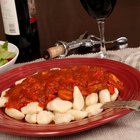
Few dishes prompt an appreciate chorus of “oohs” and “ahhs” like a steaming tray of lasagna -- and that’s before you even slice into it. Since lasagna tends to go the distance, it is common to have plenty left over. And this is where you’re in luck, because as great as your lasagna tastes the day you serve it, it may taste even better after the pasta, sauce, cheeses and other ingredients have had time to congeal in the freezer. Learn how to best freeze your Italian specialty--and then look forward to the day when you can hear an encore chorus.
Step 1
Let your leftover lasagna cool to room temperature. Don't let it overstay its "welcome" on your counter; the sooner you move your lasagna to the freezer, the better your lasagna will taste once you reheat it.
Step 2
Check the temperature in your freezer. If your freezer does not have a thermostat, use a freezer thermometer to ensure that the temperature is about 0 degree Fahrenheit.
Step 3
Gather some freezer- safe and microwave-safe, airtight plastic containers. Your goal is to freeze the leftover lasagna in individual serving sizes rather than, say, in a half tray. Small containers should be easier to store in your freezer. Plus, individual servings make reheating a breeze and should reduce the likelihood of contending with leftovers from your original leftovers.
Step 4
Cut up your lasagna into individual serving sizes. Cut bigger slices for big eaters and smaller slices for smaller appetites. Put each slice into its own plastic container.
Step 5
Label the plastic containers if you think you’ll be storing the lasagna for up to two months, the recommended freezing time. You may think you’ll remember the contents today, while the aroma of lasagna is still in the air. But if you freeze food often, lasagna may look similar to other red pasta dishes from a quick peek into your freezer. Write the date on the label, too.
Step 6
Store the containers in your freezer in a single layer so that the lasagna freezes quickly. This will prevent ice chunks from forming, which can make the noodles watery when you reheat the lasagna.
Related Articles

Freezing a Moussaka

How Long Is Leftover Spaghetti Good to ...

How to Reheat Lasagna

Can You Make Chicken Fettuccine Alfredo ...
Can You Freeze Eggplant Parmesan After ...
Italian Food Nutritional Values
Can I Make Quiche Ahead of Time?

How to Freeze Canned Cranberry Sauce

How to Store Pasta Sauce
Freezing a Dish With Sour Cream in It

How Long Can You Refrigerate Nacho ...
Can Lasagna Be Preassembled With Egg As ...
Do You Have to Cook Lasagna Before ...

How to Freeze Spinach

Make-Ahead Lasagna Tips

Can I Prepare Baked Brie Ahead of Time?

How to Freeze Marinara Sauces

How to Make Homemade Mac & Cheese

How to Make Cottage Cheese Lasagna

How to Store Smoothies in the Fridge
References
Writer Bio
With education, health care and small business marketing as her core interests, M.T. Wroblewski has penned pieces for Woman's Day, Family Circle, Ladies Home Journal and many newspapers and magazines. She holds a master's degree in journalism from Northern Illinois University.
Photo Credits
George Doyle/Stockbyte/Getty Images